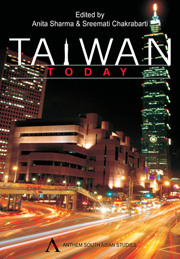Book contents
- Frontmatter
- Contents
- Acknowledgements
- Contributors to this Volume
- Acronyms and Abbreviations
- Foreword
- Introduction
- 1 Who are We? Identity in Transition
- 2 Taiwan: Yearning for an Identity
- 3 The Implications of Direct Flights: Beijing in Taiwanese Politics
- 4 Kuomintang, Democratization and the One-China Principle
- 5 The Deepening and Consolidation of Democracy in Taiwan
- 6 India and Taiwan: Bolstering Complementarity in Information Technology
- 7 Asian Regional Economic Integration and Taiwan–India Economic Relations
- 8 The Taiwan Factor in Sino–Indian Relations
- 9 Japan's Triumphant Diplomacy in Taiwan in 1874
- 10 A Study of the Cultural and Educational Exchanges between Taiwan and India, 1995–2006
- 11 Between Two Worlds: A Survey of Education in Taiwan
- 12 Female Immigrants, Social Capital and Public Sphere in Taiwan
- 13 Information Technology and Gender: Taiwan and India
- 14 Tzu Chi: A Case Study of Engaged Buddhism in Taiwan
- 15 Master Hsing Yun of Fo Guang Shan and the Development of Humanistic Buddhism
- 16 The Heritage and Innovation of Chan Paintings in Taiwan
- 17 Taiwan in World Architecture: A Historical Perspective
- Afterword
11 - Between Two Worlds: A Survey of Education in Taiwan
Published online by Cambridge University Press: 05 March 2012
- Frontmatter
- Contents
- Acknowledgements
- Contributors to this Volume
- Acronyms and Abbreviations
- Foreword
- Introduction
- 1 Who are We? Identity in Transition
- 2 Taiwan: Yearning for an Identity
- 3 The Implications of Direct Flights: Beijing in Taiwanese Politics
- 4 Kuomintang, Democratization and the One-China Principle
- 5 The Deepening and Consolidation of Democracy in Taiwan
- 6 India and Taiwan: Bolstering Complementarity in Information Technology
- 7 Asian Regional Economic Integration and Taiwan–India Economic Relations
- 8 The Taiwan Factor in Sino–Indian Relations
- 9 Japan's Triumphant Diplomacy in Taiwan in 1874
- 10 A Study of the Cultural and Educational Exchanges between Taiwan and India, 1995–2006
- 11 Between Two Worlds: A Survey of Education in Taiwan
- 12 Female Immigrants, Social Capital and Public Sphere in Taiwan
- 13 Information Technology and Gender: Taiwan and India
- 14 Tzu Chi: A Case Study of Engaged Buddhism in Taiwan
- 15 Master Hsing Yun of Fo Guang Shan and the Development of Humanistic Buddhism
- 16 The Heritage and Innovation of Chan Paintings in Taiwan
- 17 Taiwan in World Architecture: A Historical Perspective
- Afterword
Summary
INTRODUCTION
‘In education there should be no discrimination among classes.’
ConfuciusTaiwan, an island in the South China Sea has a total area of 22,214 sq. km, and a population of 23 million. According to per capita income it ranks thirty-fourth in the world. Within 40 years it has rapidly developed from a predominantly agricultural to a highly industrialized economy. Education has played an important role in transforming its economy and society.
The Portuguese in the fourteenth century called Taiwan ‘Isla Formosa’ or ‘beautiful island’. Formosa later came to be known as Taiwan meaning ‘terraced bay’. In AD 1626, Verenigde Oostindische Compagnie (VOC) or the Dutch East India Company captured Keelung and subsequently Tansui in AD 1629. The Dutch organized labour, created mines and plantations and introduced new crops and tools. Taiwan became a cog in the wheel of international commerce stretching from Nagasaki to the Netherlands. The records of the VOC contain interesting letters sent from Batavia on the role of Taiwan as an entrepôt for the exchange of gold, silk and ceramics. The Dutch also took upon themselves the responsibility of ‘civilizing’ the aborigines through conversion to Christianity. During the Dutch rule, many missionaries educated the Taiwanese natives, and it can be said that the Dutch were the first to introduce some kind of an organized system of education in Taiwan.
- Type
- Chapter
- Information
- Taiwan Today , pp. 140 - 153Publisher: Anthem PressPrint publication year: 2010



